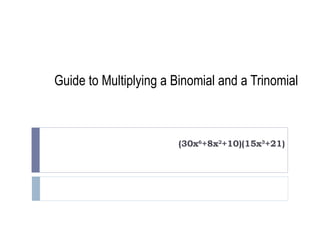Report
Share

More Related Content
What's hot
What's hot (17)
Linear Equations - Conditions for Unique Solutions

Linear Equations - Conditions for Unique Solutions
Similar to Multiplying polynomials powerpoint
Similar to Multiplying polynomials powerpoint (20)
WCS Specialist Maths An Introduction to Matrices PowerPoint

WCS Specialist Maths An Introduction to Matrices PowerPoint
More from 40501894
More from 40501894 (7)
Multiplying polynomials powerpoint
- 1. Guide to Multiplying a Binomial and a Trinomial (30x 6 +8x 2 +10)(15x 3 +21)
- 2. 21 16x 6 8x 2 15x 3 10 In this first step you will have to make a box to solve the equation. This is a multiplication box and in this box you HAVE to multiply the coefficients only and add the exponents together . Note: Keep the numbers in order throughout the entire problem 240x 8 120x 5 150x 3 336x 8 168x 2 210
- 3. In the second step according to your numbers you MUST put the numbers into order. You will have to put it into descending order. Descending order is simply greatest to least. The descending order goes by exponents. Put the greatest exponents first and so on. 336x 8 +240x 8 +120x 5 +150x 3 +168x 2 +210 240x 8 120x 5 150x 3 336x 8 168x 2 210
- 4. 336x 8 +240x 8 +120x 5 +150x 3 +168x 2 +210 576 16 +120x 5 +150x 3 +168x 2 +210 This is the third step that you combine like terms. This is meaning you combine all the numbers that are the same. When you combine the numbers make sure to ADD them if not you can get an incorrect answer.
- 5. The final answer to the equation is……… 576 16 +120x 5 +150x 3 +168x 2 +210